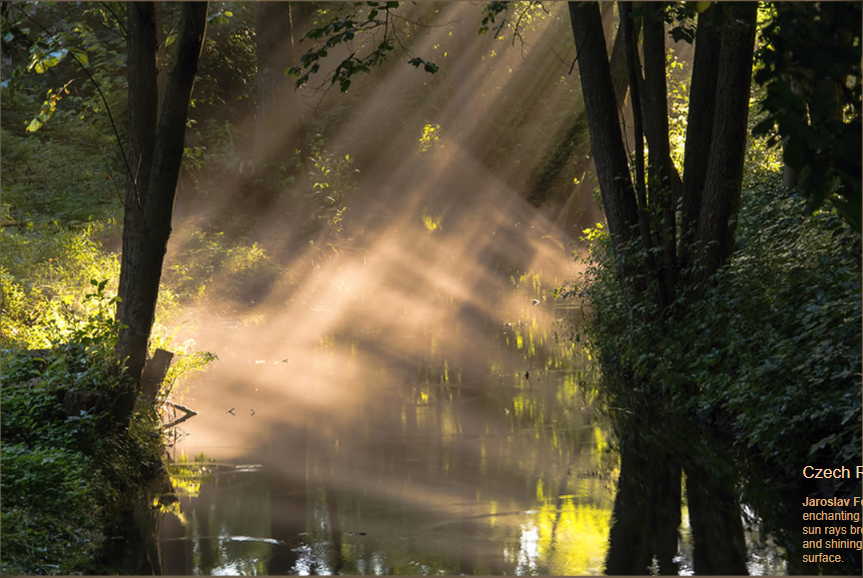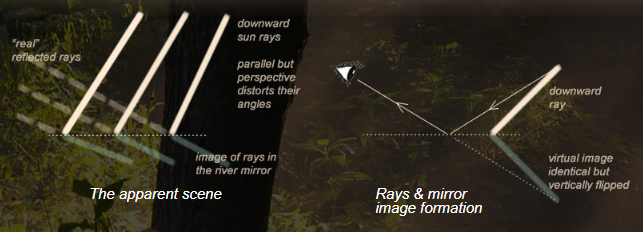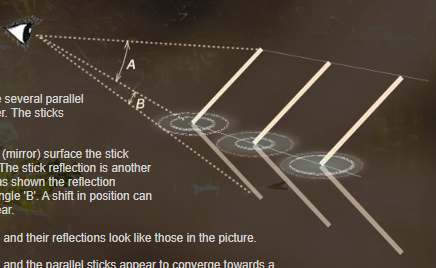River reflected crepuscular rays, a puzzle - OPOD
River Reflected Crepuscular Rays: A Puzzle - OPOD
Have you ever witnessed the enchanting sight of sun rays breaking through trees and shining on the surface of a smooth river? Jaroslav Fous captured this captivating morning scene, showcasing rays of light reflecting from the water and forming mirror images. However, there is a puzzling aspect to these river-reflected crepuscular rays that defies our expectations.
When we observe this phenomenon, we notice two types of rays: downward sun rays formed by gaps in trees and upward rays reflected from the river's surface. Both types of rays exist in real space, can be touched, and show perspective effects. However, the river's surface adds a complicating factor by creating virtual mirror images of these rays.
The challenge lies in differentiating between the "real" reflected rays and their mirror images. The mirror images have shallower slopes compared to the incident rays. This seems contradictory to our understanding that a mirror should produce rays with the same slopes as the incident rays, as we are often told that "the angles of incidence and reflection are the same."
However, this apparent contradiction arises from our expectation that reflections in a mirror should look identical (except for being flipped) to the real object. In reality, they do not. The angles at which the reflected rays appear differ from the incident rays due to the complex interplay of light and the reflective properties of the water's surface.
To better understand this phenomenon, let's consider an analogy with parallel sticks instead of sun rays. If we imagine several parallel but sloping sticks placed in the river, they would behave similarly to the rays of light. When viewed from above the water's surface (which acts as a mirror), the sticks would appear to subtend a large angle. However, when we observe their reflections from a specific eye position, the reflected image subtends a much smaller angle. Furthermore, a slight shift in position can cause the reflection to disappear altogether.
Now, let's imagine tilting these sticks sideways. The reflections they create would resemble the pattern observed in the picture of the river-reflected crepuscular rays. When we bring our eye close to the surface of the water, we notice that the parallel sticks or rays appear to converge towards a "vanishing point," much like the sun's rays.
Describing and illustrating this complex 3D geometry is challenging, but you can conduct a simple experiment to gain a better understanding. Hold a pencil at an angle on a horizontal mirror and observe how its reflection behaves when you bring your eye close to the mirror's surface. This experiment will help you grasp the behavior of reflections and how they can deviate from our expectations.
In conclusion, the puzzle of river-reflected crepuscular rays arises from our anticipation that reflections in a mirror should precisely replicate the incident rays. However, due to the intricate nature of light and reflection on the water's surface, the angles at which the reflected rays appear differ from the incident rays. Understanding this phenomenon requires considering the 3D geometry involved and conducting simple experiments to observe how reflections behave in different contexts.
Note: This article has been automatically converted from the old site and may not appear as intended. For the original article, please visit the provided link.

Czech River Rays
Jaroslav Fous caught this enchanting morning scene of sun rays breaking through trees and shining on a smooth river surface.
Some rays are reflected back upwards from the water, there are also mirror images.
But which are which? Why are their angles not what you would expect?
Image ©Jaroslav Fous, shown with permission
The scene has downward sun rays formed by gaps in trees and upward rays reflected from the river surface.
Both are corporeal, they exist in real space, they can be touched, walked around, they show perspective effects.
As a complication the surface forms virtual mirror images of all these!
The ‘real’ reflected rays are hard to separate from the mirror images and they have shallower slopes. Surely a mirror should produce rays with the same slopes as the incident rays? “The angles of incidence and reflection are the same” – we are told.
There is no violation of reflection laws. The apparent contradiction arises from our expectation that reflections in a mirror look the same (except for being flipped) as the real object.
They do not.


Rays & Sticks
Instead of sun rays imagine several parallel but sloping sticks in the river. The sticks behave the same as rays.
To the eye above the water (mirror) surface the stick subtends a large angle 'A'. The stick reflection is another matter. In the eye position as shown the reflection subtends a much smaller angle 'B'. A shift in position can make the reflection disappear.
Now tilt the sticks sideways and their reflections look like those in the picture.
Bring the eye close enough and the parallel sticks appear to converge towards a 'vanishing point' as do the sun's rays.
This 3D geometry is hard to draw and describe. Do an experiment. Hold a pencil at an angle on a horizontal mirror. Get your eye close and see how the pencil's reflection behaves.
Note: this article has been automatically converted from the old site and may not appear as intended. You can find the original article here.
Reference Atmospheric Optics
If you use any of the definitions, information, or data presented on Atmospheric Optics, please copy the link or reference below to properly credit us as the reference source. Thank you!
-
<a href="https://atoptics.co.uk/blog/river-reflected-crepuscular-rays-a-puzzle-opod-2/">River reflected crepuscular rays, a puzzle - OPOD</a>
-
"River reflected crepuscular rays, a puzzle - OPOD". Atmospheric Optics. Accessed on April 18, 2024. https://atoptics.co.uk/blog/river-reflected-crepuscular-rays-a-puzzle-opod-2/.
-
"River reflected crepuscular rays, a puzzle - OPOD". Atmospheric Optics, https://atoptics.co.uk/blog/river-reflected-crepuscular-rays-a-puzzle-opod-2/. Accessed 18 April, 2024
-
River reflected crepuscular rays, a puzzle - OPOD. Atmospheric Optics. Retrieved from https://atoptics.co.uk/blog/river-reflected-crepuscular-rays-a-puzzle-opod-2/.